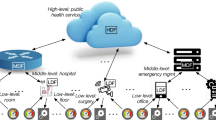Abstract
Internet of Things (IoT) is enhancing the intelligence of the societies through a rapid transition to a smarter, automatic, responsive world due to the dramatic increase in the number of sensors deployed around the world. Collecting, modeling, and reasoning data generated by sensors play a crucial role in data analysis. Analyzing and interpreting real-time information transmitted through heterogeneous wireless networks are challenges that IoT applications encounter. Complex Event Processing (CEP) is a data stream tracking method used to extract the meaningful data obtained from the network results in real-time decision making. Instance data analysis, early diagnosis, and effective treatment of patients through the massive volume of data are considered indispensable parameters that have made the healthcare industry more reliant on real-time event processing than other industries. To achieve actionable insights, forecasting anomaly, and increasing healthcare quality, applying the CEP method is introduced in this area. In this paper, an event-driven IoT architecture is presented for data analysis of reliable healthcare applications, including context, event, and service layers. Dependability parameters are considered in each layer, and the CEP method as a novel solution and automated intelligence is applied in the event layer. Implementation results showed that the CEP method increased reliability, reduced costs, and improved healthcare quality.












Similar content being viewed by others
References
Perera, C., Zaslavsky, A., Christen, P., Georgakopoulos, D.: Context aware computing for the internet of things: a survey. IEEE Commun. Surv. Tutor. 16(1), 414–454 (2013)
H. Zhao, Y. Yang (2015) A data generation algorithm for internet of things based on complex event processing. In: 2015 IEEE International Conference on Smart City/SocialCom/SustainCom (SmartCity), pp. 827–831.
Lee, S., Chang, J., Lee, S.: Survey and trend analysis of context-aware systems. Inform. Int. Interdiscip. J. 14(2), 527–548 (2011)
Cugola, G., Margara, A.: Processing flows of information: from data stream to complex event processing. ACM Comput. Surv. 44(3), 1–62 (2012a)
N. Mao, J. Tan (2015) Complex event processing on uncertain data streams in product manufacturing process. In 2015 International Conference on Advanced Mechatronic Systems (ICAMechS), pp. 583–588.
J. Lee, B. Hong, C. Kim, W. C. Kim (2019) Development of a continuous complex event processing platform for real-time tactical moving objects. In 2019 IEEE International Conference on Big Data (Big Data), pp. 6122–6124.
F. Xiao, C. Zhan, H. Lai, L. Tao (2017) Parallel processing data streams in complex event processing systems. In: 2017 29th Chinese Control And Decision Conference (CCDC), 2017, 6157–6160.
Wang, Y., Li, Q.: Proactive complex event processing for transportation internet of things. In: 2015 IEEE 34th International Performance Computing and Communications Conference (IPCCC), pp. 1–2 (2015).
Terroso-Sáenz, F., Valdés-Vela, M., Campuzano, F., Botia, J.A., Skarmeta-Gómez, A.F.: A complex event processing approach to perceive the vehicular context. Inf. Fusion 21, 187–209 (2015)
Yuan, B., Herbert, J.: Web-based real-time remote monitoring for pervasive healthcare. In: 2011 IEEE International Conference on Pervasive Computing and Communications Workshops (PERCOM Workshops), pp. 625–629 (2011).
Babaei, Z., Rahmani, A. M., Rezaei, A.: Real-time reusable event-driven architecture for context aware systems, (2016). doi: https://doi.org/10.1109/IranianCEE.2016.7585535.
Wu, D., Shi, H., Wang, H., Wang, R., Fang, H.: A feature-based learning system for Internet of Things applications. IEEE Internet Things J. 6(2), 1928–1937 (2018)
Petersen, E., Rlict, M. A. T., Maag, S., Yamga, T.: An unsupervised rule generation approach for online complex event processing. In: 2018 IEEE 17th International Symposium on Network Computing and Applications (NCA), pp. 1–8 (2018).
Li, Q., Zhong, J., Tao, Y., Li, L., Miao, X.: Research of the processing technology for time complex event based on LSTM. Cluster Comput. 22(4), 9571–9579 (2019)
Zhou, C., Feng, Y., Yin, Z.: An algebraic complex event processing method for cyber-physical system. Cluster Comput. 22(6), 15169–15177 (2019)
Wei, X., Zhuang, Y., Li, H., Liu, Z.: Reliable stream data processing for elastic distributed stream processing systems. Cluster Comput. 23(2), 555–574 (2020)
Hallé, S.: From complex event processing to simple event processing. arXiv: 1702.08051 (2017).
Jayasekara, S., Kannangara, S., Dahanayakage, T., Ranawaka, I., Perera, S., Nanayakkara, V.: Wihidum: distributed complex event processing. J. Parallel Distrib. Comput. 79, 42–51 (2015)
Cugola, G., Margara, A.: Low latency complex event processing on parallel hardware. J. Parallel Distrib. Comput. 72(2), 205–218 (2012b)
Kraijak, S., Tuwanut, P.: A survey on IoT architectures, protocols, applications, security, privacy, real-world implementation and future trends, (2015).
Datta, P., Sharma, B.: A survey on IoT architectures, protocols, security and smart city based applications. In: 2017 8th International Conference on Computing, Communication and Networking Technologies (ICCCNT), pp. 1–5 (2017).
Garg, S.K., Versteeg, S., Buyya, R.: A framework for ranking of cloud computing services. Futur. Gener. Comput. Syst. 29(4), 1012–1023 (2013)
Hosseinzadeh, M., Koohpayehzadeh, J., Omar Bali, A., Asghari, P., Souri, A., Mazaherinezhad, A., Bohlouli, M., Rawassizadeh, R.: A diagnostic prediction model for chronic kidney disease in internet of things platform. Multimedia Tools Appl (2020). https://doi.org/10.1007/s11042-020-09049-4
Hosseinzadeh, M., Koohpayehzadeh, J., Omar Bali, A., Afshin Rad, F., Souri, A., Mazaherinezhad, A., Rezapour, A., Bohlouli, M.: A review on diagnostic autism spectrum disorder approaches based on the Internet of Things and Machine Learning. J. Supercomputing. (2020). https://doi.org/10.1007/s11227-020-03357-0
Souri, A., Yassin Ghafour, M., Mahmood Ahmed, A., Safara, F., Yamini, A., Hoseyninezhad, M.: A new machine learning-based healthcare monitoring model for student’s condition diagnosis in Internet of Things environment. Soft Computing (2020). https://doi.org/10.1007/s00500-020-05003-6
Acknowledgements
This work, including design and implementation of the wearable module and corresponding software, were performed in the Pooyandegan Rah SAADAT biomedical engineering company of Iran.
Author information
Authors and Affiliations
Corresponding author
Additional information
Publisher's Note
Springer Nature remains neutral with regard to jurisdictional claims in published maps and institutional affiliations.
Rights and permissions
About this article
Cite this article
Rahmani, A.M., Babaei, Z. & Souri, A. Event-driven IoT architecture for data analysis of reliable healthcare application using complex event processing. Cluster Comput 24, 1347–1360 (2021). https://doi.org/10.1007/s10586-020-03189-w
Received:
Revised:
Accepted:
Published:
Issue Date:
DOI: https://doi.org/10.1007/s10586-020-03189-w




